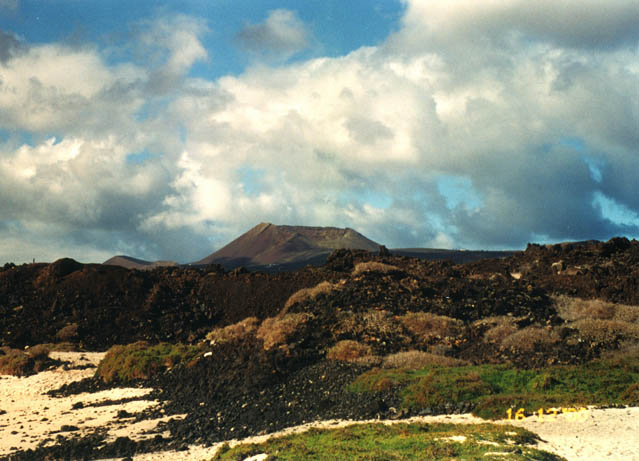Behind the northern border of Punta de Mujeres, you can admire the fascinating and rugged landscape of the Malpais de la Corona, that is, the area flooded with lava from Corona volcano thousands of years ago, which slowly comes back to life in the form of lichens and small green tabaibas. Persons, who want to take a little longer walk, can go on foot from Punta Mujeres to Jameos del Agua on the phenomenal trail along the coast. The three-kilometer route is not difficult, and its passage provides a truly extraordinary experience.
Jameos del Agua A bit closer to the coast, kilometer or a kilometer from Cueva de los Verdes, you can see another work of Manriąue -Jameos del Agua. In the Guanche language, the word jameo meant a fissure in the ground formed after the collapse of a volcanic cave ceiling.. Jameos del Agua is a complex of interconnected caves located on the seafront, transformed by Cesar Manrique into a masterpiece of applied arts. First, you go down the long and steep stairs to the cave, in which, amidst tropical greenery and atmospheric music, the brilliant artist located a cafe that blends in perfectly with the surroundings. A cup of coffee in such a beautiful and peaceful place tastes better than great. Then you go through the dark grotto – thousands of small white crabs live in the natural salt lake, which covers most of it. Passing the tables and the dance floor (folk music concerts are held here every Wednesday in August and on the first Wednesday of September) along the steps, you reach a place taken alive from an exotic postcard – A large blue pond appears to the astonished tourists, over which a lonely palm tree leans over. Another cave was transformed into a concert hall for 600 people. There is also the extremely interesting and informative Casa de los Volcanes on the premises (Museum of Volcanology).
sweet tabaiba
Tabaibas are an inseparable element of the Lanzarote landscape, that is, bushes with fancifully bent twigs, ended with small green leaves. The shrubs come from the spurge family and are an endemic species. The Guanches already knew these plants, who used tabaiba dulce juice (sweet tabaiba) as an anti-infection agent, while the hallucinogenic juice of tabaiba amarga (bitter tabaiba) drugged fish floating in small coves.
Cave of the Greens
In the distance from Arriety, o 4 km Cave of the Greens (The Green Cave) looking for green in vain – its name comes from the surname of the shepherds, to which she belonged in the past. The grotto is open to visitors in 1964 r. it is an almost two-kilometer labyrinth of corridors and caves, illuminated by an artist from Lanzarote, Jesus Soto. During the almost hour-long trip, you can see different colored lava layers and interesting rock formations (including stalactite-like igneous formations hanging from the vault). There is also a surprise: something, what you must see! A classical concert hall has been arranged in one of the underground caverns, perfect acoustics.
The cave is slightly cooler than the outside, however, it is not necessary to take warm clothes with you. The route runs through low and narrow tunnels, therefore you have to be very careful, so as not to hurt yourself, and people suffering from back diseases should perhaps withdraw from the trip.
Tunnels and volcanic caves
A very interesting volcanic formation, which can be seen in the Canary Islands, there are underground tunnels carved by lava flows. Arose, when, as a result of contact with cool air, the outer layer of the hot jet has solidified, forming a kind of crust, under which the molten rock passed. Inside the tunnels there are caves of various sizes and shapes, created as a result of the explosion of gases accumulated in the lava.. Smaller or larger tunnels can be viewed on all islands – some of them are still being investigated by scientists, others have been made available to visitors, and some of them serve young people as an ideal place for atmospheric night events.
The most famous and longest volcanic tunnel on the islands was created 4 thousand. years ago in Lanzarote after the eruption of the mighty Volcan de la Corona. Numbering over 6 km, the corridor runs from the foot of the volcano near the town of Ye do 1,5 km deep into the sea. Two parts of the tunnel, Cueva de los Verdes oraz Jameos del Agua, are made available to visitors. The part hidden under the water surface called the Atlantis Tunnel can only be seen during special diving trips organized by specialized companies.
